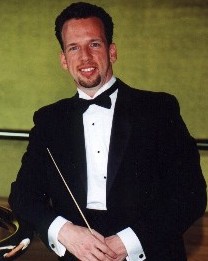On tonight's show:
Colorado Symphony Orchestra
From this season's Masterworks Series, associate conductor Scott O’Neil and the Orchestra play Moussorgsky's tribute to his friend Victor Hartmann.
Modeste Moussorgsky (Orch. Maurice Ravel): Pictures at an Exhibition
Scott ONeil, conductor
Recorded 2/20/10
Lamont School of Music
CSO principal hornist Michael Thornton talks about his first meeting with composer Eric Ewazen, who is in residence at the Lamont School of Music, followed by a performance of his music.
Eric Ewazen: “Dance” from Ballade, Pastorale and Dance
Michael Thornton, horn
Anne Epperson, piano
Julie Duncan Thornton, flute
KVOD Performance Studio: recorded 12/15/05
Produced by Martin Skavish
Fort Collins Symphony Orchestra
Charley notes that CSO concertmaster Yumi Hwang Williams is playing the Sibelius Concerto with the Fort Collins Symphony this weekend.
John Adams: "Meditative" (2nd movement) & "40% Swing" from Road Movies
Yumi Hwang-Williams, violin
David Korevaar, piano
KVOD Performance Studio: recorded 6/6/08
Produced by Martin Skavish
Boulder Chamber Orchestra
Boulder Chamber Orchestra music director Bahman Saless talks about their concerts this weekend.
Program Notes
Modeste Moussorgsky (1839-1881): Pictures at an Exhibition (Orchestrated by Maurice Ravel)
Promenade: Allegro guisto nel modo russico; senza
allegrezza ma poco sostenuto
I. Gnomus: Vivo
Promenade: Moderato comodo e con delicatezza
II. Il vecchio castello (The old castle). Andante molto cantabile e con dolore
Promenade: Moderato non tanto, pesante
III. Tuileries: Allegretto non troppo, capriccioso
IV. Bydlo: Sempre moderato pesante
Promenade: Tranquillo
V. Ballet of the Unhatched Chicks: Scherzino, Vivo
leggiero
VI. Samuel Goldenberg and Schmuyle
VII. The Market Place at Limoges: Allegro vivo, sempre
scherzando
VIII. Catacombae, Sepulchrum Romanum: Largo
Cum mortuis in lingua mortua: Andante non troppo,
con lamento
IX. The Hut on Fowls' Legs (Baba-Yaga): Allegro con
brio, feroce
X. The Great Gate of Kiev: Allegro alla breve;
Maestoso; Con grandezza
In 1874 a memorial exhibition of some 400 paintings and drawings by Victor Hartmann was organized by critic Vladimir Stassov and Count Paul Suzor, president of the Architect's Society, in the galleries of the Academy of the Arts in St. Petersburg. Hartmann's death the year before was a shock to his friend Modeste Moussorgsky. "What a terrible blow!" he wrote. "Why should a dog, a horse, a rat have life, and creatures like Hartmann must die? There can and must be no consolation--it is a rotten mortality!"
Moussorgsky was inspired by the exhibition to write a piano suite "in memory of our dear Victor" titled Pictures at an Exhibition. The work went swiftly. "Sounds and ideas float in the air," he said, "and my scribbling can hardly keep pace with them." The music was finished in less than a month, during June, 1874.
Moussorgsky's suite contains ten "pictures," interspersed with a "Promenade" meant to depict the composer himself, "roving right and left, now desultorily, now briskly, in order to get near the pictures that had caught his attention," said Stassov. "My own physiognomy peeps out through the intermezzos," wrote the composer, who weighed over two hundred pounds.
Here is a handy guide to the Pictures:
Promenade
1) "The Gnome." In his introduction to the first edition, Stassov says that Hartmann's drawing represented "a little gnome awkwardly walking on deformed legs." Elsewhere Stassov refers to "something in the style of the fabled Nutcracker, the nuts being inserted in the gnome's mouth."
Promenade
2) "The Old Castle." A troubador sings in front of a medieval castle.
Promenade
3) "In the Garden of the Tuileries." Moussorgsky's subtitle is "Dispute of the Children after Play."
4) "Bydlo." A Polish wagon, drawn by oxen.
Promenade
5) "Ballet of the Unhatched Chicks." Stassov says that "in 1870 Hartmann designed the costumes for the staging of the ballet Trilby at the Maryinsky Theater, St. Petersburg. In the cast were a number of boy and girl pupils of the theater school, arrayed as canaries. Others were dressed up as eggs."
6) "Samuel Goldenburg and Schmuyle: Two Jews, One Rich and One Poor." Moussorgsky liked this picture so much that Hartmann gave it to him.
7) "The Market place at Limoges." In the margin of the score, Moussorgsky wrote: "Great news! M. de Puissangeout has just recovered his cow. The Fugitive. But the good crones of Limoges are not entirely agreed about this, because Mme. de Remboursac just acquired a beautiful new set of teeth, whereas M. de Panta-Pantaleon's nose, which is in the way, remains the color of a peony."
8) "Catacombs, Roman Tombs" and "Cum mortuis in lingua mortua" (With the Dead in a Dead Language). In a footnote, Moussorgsky explained: "Well may it be in Latin! The creative spirit of the departed Hartmann leads me to the skulls, calls out to them, and the skulls begin to glow dimly from within."
9) "The Hut on Fowls' Legs (Baba-Yaga)." Hartmann's drawing shows a clock in the form of the hut of the Russian witch Baba-Yaga, who eats bones ground up with a mortar and pestle, which she also uses to fly through the air.
10) "The Great Gate of Kiev." Hartmann's design was submitted for city gates commemorating Tsar Alexander II's escape from assassination in 1866.
The work is scored for piccolo, 3 flutes, 3 oboes, English horn, 2 clarinets, 2 bassoons, contrabassoon, E-flat alto saxophone, 4 horns, 3 trumpets, 3 trombones, tuba, rattle, side drum, bass drum, cymbals, whip, triangle, xylophone, glockenspiel, bells, celesta, tam-tam, timpani, 2 harps, piano and strings.
©2010 Charley Samson
